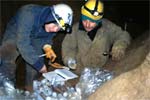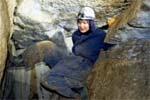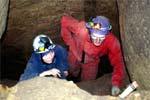Research - caves at Lake Baikal
from Sebastian Breitenbach
 If you want to get information about the exploration of the Botovskaya cave (or as well other caves in the Lake Baikal region) you will soon discover that a lot is still in the dark. Being Russia's longest cave, the Botovskaya cave is a good example:
If you want to get information about the exploration of the Botovskaya cave (or as well other caves in the Lake Baikal region) you will soon discover that a lot is still in the dark. Being Russia's longest cave, the Botovskaya cave is a good example:
In the forties (1946), students led by the geologist Odinzov were the firsts to realise an expedition to that cave. Not until 1985 the next expedition was undertaken, this time under the leadership of Pupytkins. About 1700 metres of passages were mapped. Four years later geologists scrutinised the cave, the mapping was advanced to 4.5 km. Cavities were digged, the petography was described, samples were taken. By 1992, the length had increased to 8 km. Since 1992, the speleology club "ARABIKA" has realised expeditions under the leadership of Alexander Osinzev. Since then, 57 km of passages have been measured and mapped.
 The research took a back seat. Inga Bude has investigated the micro climate in the cave for several years. Thereby the attention is especially turned to the ice at the entrance area as well as to the air temperature.
The research took a back seat. Inga Bude has investigated the micro climate in the cave for several years. Thereby the attention is especially turned to the ice at the entrance area as well as to the air temperature.
Since 2001, I have analysed the isotope relationship in stalagmites and waters in order to make a statement about the palaeontological climate of the region around the Botovskaya cave, and possibly to enlighten the genesis and the age of the cave. Especially problematical is the rareness of stalagmites in the wide entrance area of the Botovskaya cave. Furthermore, Czech cavers of the Academy of Science want to take digging samples of this cave in order to clarify the age, and want to collect further data from winter 2003/04 on. A longer project at the Geological Research Centre of Potsdam will follow, during which the palaeontological factors of various caves will be investigated.
 So far, investigations of any kind concerning fauna, palaentology, and morphogenesis of the cave are missing. Only few data concerning microclimate and geology is existent. The lack of a map with a large scale of the area of the Botovskaya cave makes it difficult to find new entrances and to develop a GIS-supported scheme.
So far, investigations of any kind concerning fauna, palaentology, and morphogenesis of the cave are missing. Only few data concerning microclimate and geology is existent. The lack of a map with a large scale of the area of the Botovskaya cave makes it difficult to find new entrances and to develop a GIS-supported scheme.
 A further problem are the inchoate investigations by geophysics of petroleum and natural gas companies, who hope for major deposits in the area of the Botovskaya cave. If this comes true, you have to wonder if the longest cave of the Russian Federation is to be protected or if it has to fall victim to the exploitation of resources. The formation of a natural park or a natural monument is to be aspired!
A further problem are the inchoate investigations by geophysics of petroleum and natural gas companies, who hope for major deposits in the area of the Botovskaya cave. If this comes true, you have to wonder if the longest cave of the Russian Federation is to be protected or if it has to fall victim to the exploitation of resources. The formation of a natural park or a natural monument is to be aspired!
 Altogether the situation of most of the South-Siberian caves (i.e. Dolganskaya Yama, Politekhnitkheskaya) is the same: namely that they have been mapped enthusiastically, but haven't been used as data archive for research so far. Moreover, scandals about companies and individuals, who have got over any kind of timidity and have (ab)used the caves (i.e. Ikoninskaya) as dumpsites for highly toxic waste, are publicised. Caves are to be protected due to their unique ecotop situation!
Altogether the situation of most of the South-Siberian caves (i.e. Dolganskaya Yama, Politekhnitkheskaya) is the same: namely that they have been mapped enthusiastically, but haven't been used as data archive for research so far. Moreover, scandals about companies and individuals, who have got over any kind of timidity and have (ab)used the caves (i.e. Ikoninskaya) as dumpsites for highly toxic waste, are publicised. Caves are to be protected due to their unique ecotop situation!

